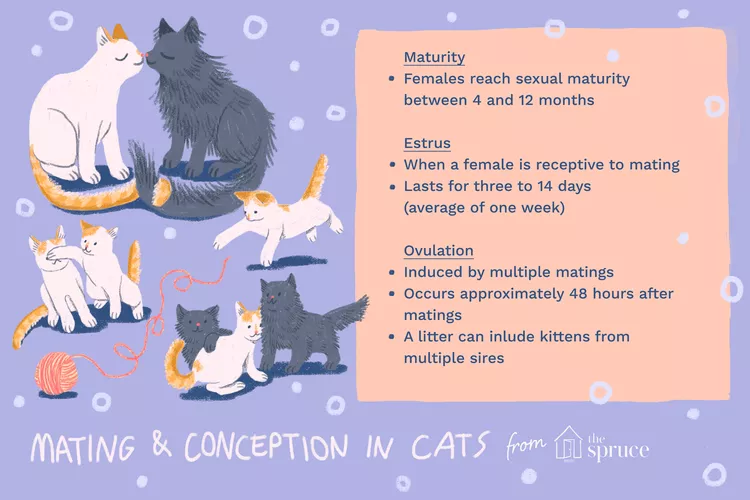How Do Cats Mate?

Most pet female cats who are not part of a breeding program should be spayed before puberty. Once they reach puberty, estrous cycles―often called heat cycles―will start. In domestic cats, heat cycles run generally from February through October in the Northern Hemisphere, but they can occur year-round in indoor cats.
Until she mates or is spayed, estrus (the time of receptivity to mating) will occur every two or three weeks, causing distress to both the queen and her human companions. During this time, Queenie's entire focus will be on escaping the house to mate or mating with an intact male housemate. She will be single-minded in her need to mate, will loudly vocalize (call), and lurk near doors, just waiting for the chance to meet up with one of the noisy feline Romeos who will cluster near your home, fighting for the privilege of impregnating your queen.
Estrus
Estrus is described as the period of receptivity to mating and is linked with the production of estradiol (a type of estrogen) produced by ovarian follicles. Unlike dogs, cats that are in heat rarely experience observable vulvar swelling or discharge.
Female cats are induced ovulators, which means that ovulation does not take place without mating or similar stimulation. If the female cat does not mate during estrus, hormonal levels will eventually drop off, and the estrous cycle will repeat itself in another two to three weeks.
Mating
The queen will signal her willingness to mate with a unique posture: chest down, forelegs bent, rear quarters raised with the tail to the side to expose the vulva (this posture is called lordosis). Her rear legs may tread rhythmically as if walking in place.
The tomcat will mount the female from the rear, often holding her on the back of the neck with his teeth and insert his penis through her vulva.
Intact male cats have barbed penises, and upon withdrawal, the female cat will often scream. It is believed that the barbed penis stimulates ovulation. In fact, breeders sometimes use male cats dubbed "Teaser Toms" to stimulate ovulation and end the estrous cycle in queens that are not yet ready for breeding. Teaser Toms are neutered by vasectomy, leaving the barbs on the penis to stimulate ovulation.
Conception
Ovulation will usually occur within 20 to 50 hours after mating. The eggs are fertilized in the oviduct, and then make their way to the uterus via the uterine horn, implanting in the uterine lining within approximately 12 to 13 days.
Common Questions
Can a Litter Contain Kittens From Multiple Sires?
Yes. On the street, a queen may mate with two or more tom cats over the length of the estrous cycle—up to 21 days, with an average of seven days. Although the genetics of the queen may come into play, multi-colored kitten litters will often vividly demonstrate multiple mating. Some breeders of pedigreed cats keep the queen and chosen tom together for multiple matings to ensure that pregnancy will result.
Can My Cat Become Pregnant While Nursing?
Unfortunately, yes. For that reason, it is critical to keep her indoors and separate from any whole males in the house. Once the mother cat starts to wean the kittens, she should be spayed to prevent further litters. In addition, the kittens should be spayed/neutered, whether kept in the original home or placed for adoption.
Can My Cat Be Spayed While Pregnant?
Generally speaking, pregnant cats can safely be spayed, although veterinarians differ about some of the factors involved.
At What Age Can a Cat Become Pregnant?
Although female cats generally mature sexually by six months, it is not unusual for a cat to start the estrous cycle as early as four months. If she is allowed to become pregnant at this age, the result will literally be a case of a kitten birthing kittens, dangerous to both the mother and the kittens. Many veterinarians are now practicing early spaying and neutering to prevent tragedies of this sort.
Spaying your female cat will not only help the overpopulation problem but will make her a happier and healthier pet in the long term.